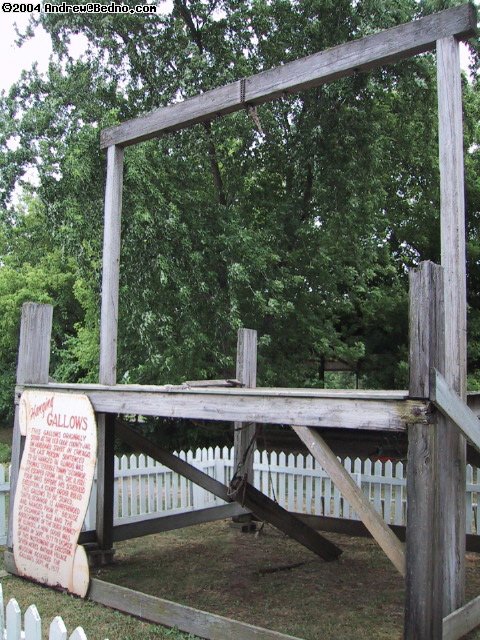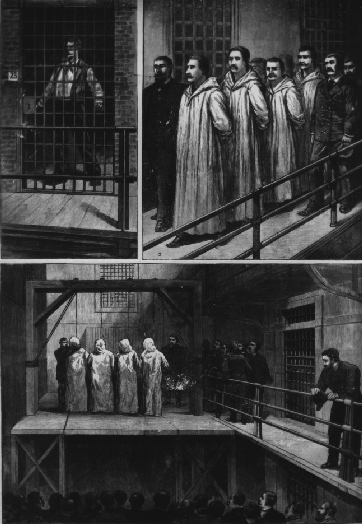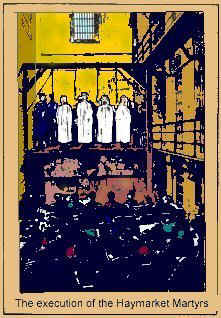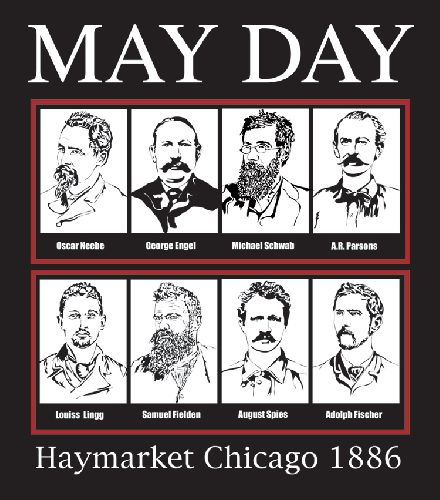Chicago Indymedia : http://chicago.indymedia.org/archive
LOCAL News :: Labor
Chicago Trib: Haymarket Gallows for Sale
As an artifact, the gallows represent a unique facet of Chicago history and the U.S. death penalty. Its first victims were labor activists, sentenced for the violent 1886 Haymarket Riot that led to the eight-hour workday. Inmates who were hanged on the device died in plain sight of other county prisoners, as capital punishment surged in early 20th Century America.



Grim bit of history for sale
By James Janega
Tribune staff reporter
Published October 18, 2006
UNION, Ill. -- All these years, the gallows hid in plain sight, the old killer's floorboards creaking above the heads of children.
As they have for decades, Cook County's retired gallows anchor a corner of Donley's Wild West Town, a tourist theme park and steakhouse that feels like an old movie set, complete with a trading post, live mules and clucking hens.
The setting is fanciful, but the gallows are jarringly real. In all, 86 inmates died on the device between 1887 and 1927.
They might have been destroyed long ago but for one convict's escape. "Terrible Tommy" O'Connor gave authorities the slip before his 1921 execution, and the gallows were kept for decades in case he was caught.
In the saga's latest turn, the gallows were set for auction in December, raising concerns about how they will be displayed in the future. Some death penalty experts worry the sale could attract morbid collectors of "murderabilia," items somehow related to serial killers and criminals.
As an artifact, the gallows represent a unique facet of Chicago history and the U.S. death penalty. Its first victims were labor activists, sentenced for the violent 1886 Haymarket Riot that led to the eight-hour workday. Inmates who were hanged on the device died in plain sight of other county prisoners, as capital punishment surged in early 20th Century America.
Those executed on the scaffolds included peddlers and gang leaders, a railroad worker and a musician. There were parolees, a clerk, a gambler, a milliner, a jockey and three butchers. Elin Lyons, a convicted murderer, died on them on June 24, 1927--the last man to hang in Cook County.
"If these gallows were purchased in the auction with people who contributed them toward a museum that shows the concrete reminders of the death penalty, then I say that's a good use of the gallows. If somebody gets them just for their own sensational kind of attraction to the bizarre ... then no," said Sister Helen Prejean, the death-penalty foe who wrote "Dead Man Walking."
The December auction will be the second sale of the gallows.
The first came in 1977, after presiding Criminal Court Judge Richard Fitzgerald gave up hope that O'Connor ever would be captured and ordered the artifact removed from the basement of the Cook County Jail. There, the gallows had spent half a century in pieces, aging in a cavernous room under a single bare bulb, waiting in vain for O'Connor to reappear.
The man who bought the structure was Mike Donley. Then in his 20s, he owned a small-town museum of Chicago artifacts. He learned the gallows were for sale from a newspaper in a grocery store checkout line and decided he had to have the curiosity.
With his father, he loaded the 16-foot timbers into a pickup truck and drove off to McHenry County.
Officials have lost records on the amount of the sale, and Donley, now 54, refuses to say what he paid.
The signs at Donley's Wild West Town give no indication it was involved at all, focusing solely and briefly on O'Connor, sentenced to die for killing a police officer during an arrest. A fictionalized version of his escape became the basis for the Broadway hit "The Front Page" and later movies based on it.
The structure stands a few feet away from an Old West-style town square with a blacksmith, trading post, ice cream parlor and photography studio with period costumes and sepia film.
On the well-kept lawn below the gallows is a mock grave with curled cowboy boots poking up between heavy rocks, along with a sign proclaiming the late wearer had "Got Shot Fer Claim Jumpin'."
The gallows are compact. The bowed 10- by 20-foot platform is at eye level. The 15-foot-high crossbar and its supports are still unshakably sturdy.
Its aged gray planks are tinged green from years of being left out in the rain. The grain has worn into deep grooves and rusted nails have crept out of settings.
But the original four noose bolts still hold tightly to the heavy crossbeam above, along with a fifth in the middle of the beam added in 1888 for the single execution of Zephyr Davis.
Donley says the time has come to sell. Over the years his museum of gangster collectibles and Chicago history, then suitable for the gallows, evolved into an Old West theme park for children, complete with a miniature steam-engine train and petting zoo.
It really doesn't fit into our theme of what we do here," he said. "It has to be preserved. It has to go to somebody else."
Bidding will start Nov. 20 through Burr Ridge-based Mastro Auctions, which will put the device in its catalog and Web site. The auction will close Dec. 6. The opening bid will be $5,000.
"There's probably going to be a big market for it, I can tell you that," said Andy Kahan, director of the mayor's crime victim assistance program in Houston.
A critic of murderabilia hoarders, Kahan has grudging respect for the market that sellers have found. "As long as they can associate a high profile serial killer or murderer with it, that's the trick."
Besides O'Connor's notoriety as a killer, the gallows' age and association with the Haymarket Riot may be enough to energize bidders.
In May 1886, radicals and anarchists joined an ongoing labor campaign. On May 4, a bomb was thrown into a crowd of demonstrators at Haymarket Square on Desplaines and Randolph Streets. One policeman died instantly and seven others soon after.
Though the bomber was never identified, eight men were tried for conspiracy to incite the crowd, and seven were sentenced to die. The Cook County gallows were built for the first four men--Albert Parsons, August Spies, Adolph Fischer and George Engel--who were hanged Nov. 11, 1887.
Another man committed suicide in prison. Sentences for two ordered to hang were commuted to life in prison, and all three surviving prisoners were later pardoned.
"It is a part of history, and I don't think you should cover it up or pretend it doesn't exist. That's different from exploiting it for entertainment," said death penalty advocate Joshua Marquis, district attorney for Oregon's Clatsop County and vice president of the National District Attorneys Association.
He said that's often a narrow distinction.
There has been a thriving market for crime-related items in recent years. Individual sellers and auctioneers have sold everything from killers' artwork to toenail clippings, including from Illinois murderers John Wayne Gacy, Richard Speck and William Heirens.
Massachusetts' electric chair cap and Tennessee's longtime electric chair have sold.
The auctioneers presume a museum or other institution will provide the winning bid for the gallows. Historical items seem to garner more respect, and the older the better, said Brian Marren, vice president of acquisitions at Mastro Auctions.
"Because it's several generations away, it's now a part of history," Marren said. "There's very few people who know personally the people who got hung in the Haymarket Riot."
But where the artifact goes next is anyone's guess, said Richard Dieter, executive director of the Death Penalty Information Center and a critic of the death penalty. "An auction can go one of two ways," he said. "I would hope it would be bought by some archive or university or state--someone who would be interested in preserving it as part of some larger historical installation."
By James Janega
Tribune staff reporter
Published October 18, 2006
UNION, Ill. -- All these years, the gallows hid in plain sight, the old killer's floorboards creaking above the heads of children.
As they have for decades, Cook County's retired gallows anchor a corner of Donley's Wild West Town, a tourist theme park and steakhouse that feels like an old movie set, complete with a trading post, live mules and clucking hens.
The setting is fanciful, but the gallows are jarringly real. In all, 86 inmates died on the device between 1887 and 1927.
They might have been destroyed long ago but for one convict's escape. "Terrible Tommy" O'Connor gave authorities the slip before his 1921 execution, and the gallows were kept for decades in case he was caught.
In the saga's latest turn, the gallows were set for auction in December, raising concerns about how they will be displayed in the future. Some death penalty experts worry the sale could attract morbid collectors of "murderabilia," items somehow related to serial killers and criminals.
As an artifact, the gallows represent a unique facet of Chicago history and the U.S. death penalty. Its first victims were labor activists, sentenced for the violent 1886 Haymarket Riot that led to the eight-hour workday. Inmates who were hanged on the device died in plain sight of other county prisoners, as capital punishment surged in early 20th Century America.
Those executed on the scaffolds included peddlers and gang leaders, a railroad worker and a musician. There were parolees, a clerk, a gambler, a milliner, a jockey and three butchers. Elin Lyons, a convicted murderer, died on them on June 24, 1927--the last man to hang in Cook County.
"If these gallows were purchased in the auction with people who contributed them toward a museum that shows the concrete reminders of the death penalty, then I say that's a good use of the gallows. If somebody gets them just for their own sensational kind of attraction to the bizarre ... then no," said Sister Helen Prejean, the death-penalty foe who wrote "Dead Man Walking."
The December auction will be the second sale of the gallows.
The first came in 1977, after presiding Criminal Court Judge Richard Fitzgerald gave up hope that O'Connor ever would be captured and ordered the artifact removed from the basement of the Cook County Jail. There, the gallows had spent half a century in pieces, aging in a cavernous room under a single bare bulb, waiting in vain for O'Connor to reappear.
The man who bought the structure was Mike Donley. Then in his 20s, he owned a small-town museum of Chicago artifacts. He learned the gallows were for sale from a newspaper in a grocery store checkout line and decided he had to have the curiosity.
With his father, he loaded the 16-foot timbers into a pickup truck and drove off to McHenry County.
Officials have lost records on the amount of the sale, and Donley, now 54, refuses to say what he paid.
The signs at Donley's Wild West Town give no indication it was involved at all, focusing solely and briefly on O'Connor, sentenced to die for killing a police officer during an arrest. A fictionalized version of his escape became the basis for the Broadway hit "The Front Page" and later movies based on it.
The structure stands a few feet away from an Old West-style town square with a blacksmith, trading post, ice cream parlor and photography studio with period costumes and sepia film.
On the well-kept lawn below the gallows is a mock grave with curled cowboy boots poking up between heavy rocks, along with a sign proclaiming the late wearer had "Got Shot Fer Claim Jumpin'."
The gallows are compact. The bowed 10- by 20-foot platform is at eye level. The 15-foot-high crossbar and its supports are still unshakably sturdy.
Its aged gray planks are tinged green from years of being left out in the rain. The grain has worn into deep grooves and rusted nails have crept out of settings.
But the original four noose bolts still hold tightly to the heavy crossbeam above, along with a fifth in the middle of the beam added in 1888 for the single execution of Zephyr Davis.
Donley says the time has come to sell. Over the years his museum of gangster collectibles and Chicago history, then suitable for the gallows, evolved into an Old West theme park for children, complete with a miniature steam-engine train and petting zoo.
It really doesn't fit into our theme of what we do here," he said. "It has to be preserved. It has to go to somebody else."
Bidding will start Nov. 20 through Burr Ridge-based Mastro Auctions, which will put the device in its catalog and Web site. The auction will close Dec. 6. The opening bid will be $5,000.
"There's probably going to be a big market for it, I can tell you that," said Andy Kahan, director of the mayor's crime victim assistance program in Houston.
A critic of murderabilia hoarders, Kahan has grudging respect for the market that sellers have found. "As long as they can associate a high profile serial killer or murderer with it, that's the trick."
Besides O'Connor's notoriety as a killer, the gallows' age and association with the Haymarket Riot may be enough to energize bidders.
In May 1886, radicals and anarchists joined an ongoing labor campaign. On May 4, a bomb was thrown into a crowd of demonstrators at Haymarket Square on Desplaines and Randolph Streets. One policeman died instantly and seven others soon after.
Though the bomber was never identified, eight men were tried for conspiracy to incite the crowd, and seven were sentenced to die. The Cook County gallows were built for the first four men--Albert Parsons, August Spies, Adolph Fischer and George Engel--who were hanged Nov. 11, 1887.
Another man committed suicide in prison. Sentences for two ordered to hang were commuted to life in prison, and all three surviving prisoners were later pardoned.
"It is a part of history, and I don't think you should cover it up or pretend it doesn't exist. That's different from exploiting it for entertainment," said death penalty advocate Joshua Marquis, district attorney for Oregon's Clatsop County and vice president of the National District Attorneys Association.
He said that's often a narrow distinction.
There has been a thriving market for crime-related items in recent years. Individual sellers and auctioneers have sold everything from killers' artwork to toenail clippings, including from Illinois murderers John Wayne Gacy, Richard Speck and William Heirens.
Massachusetts' electric chair cap and Tennessee's longtime electric chair have sold.
The auctioneers presume a museum or other institution will provide the winning bid for the gallows. Historical items seem to garner more respect, and the older the better, said Brian Marren, vice president of acquisitions at Mastro Auctions.
"Because it's several generations away, it's now a part of history," Marren said. "There's very few people who know personally the people who got hung in the Haymarket Riot."
But where the artifact goes next is anyone's guess, said Richard Dieter, executive director of the Death Penalty Information Center and a critic of the death penalty. "An auction can go one of two ways," he said. "I would hope it would be bought by some archive or university or state--someone who would be interested in preserving it as part of some larger historical installation."
Information Library
Views
Search
Account Login
Media Centers
- worcester
- western mass
- vermont
- urbana-champaign
- tennessee
- tampa bay
- seattle
- sarasota
- santa cruz, ca
- santa barbara
- san francisco bay area
- san francisco
- san diego
- saint louis
- rogue valley
- rochester
- richmond
- portland
- pittsburgh
- philadelphia
- oklahoma
- nyc
- north texas
- north carolina
- new orleans
- new mexico
- new hampshire
- minneapolis/st. paul
- milwaukee
- michigan
- miami
- maine
- madison
- la
- kansas city
- hudson mohawk
- houston
- hawaii
- dc
- columbus
- colorado
- cleveland
- chicago
- charlottesville
- buffalo
- boston
- binghamton
- big muddy
- baltimore
- austin indymedia
- austin
- atlanta
- asheville
- arkansas
- arizona
- valencia
- united kingdom
- ukraine
- toulouse
- toscana
- torun
- switzerland
- sverige
- scotland
- sardegna
- russia
- romania
- roma
- portugal
- poland
- piemonte
- patras
- paris/Île-de-france
- oost-vlaanderen
- nottingham
- norway
- northern england
- nice
- netherlands
- napoli
- nantes
- marseille
- malta
- madrid
- london
- lombardia
- linksunten
- lille
- liguria
- liege
- la plana
- italy
- istanbul
- ireland
- hungary
- grenoble
- germany
- galiza
- euskal herria
- estrecho / madiaq
- emilia-romagna
- cyprus
- croatia
- calabria
- bulgaria
- brussels
- bristol
- belgrade
- belgium
- belarus
- barcelona
- austria
- athens
- armenia
- antwerpen
- andorra
- alacant
- abruzzo
This site made manifest by dadaIMC software




